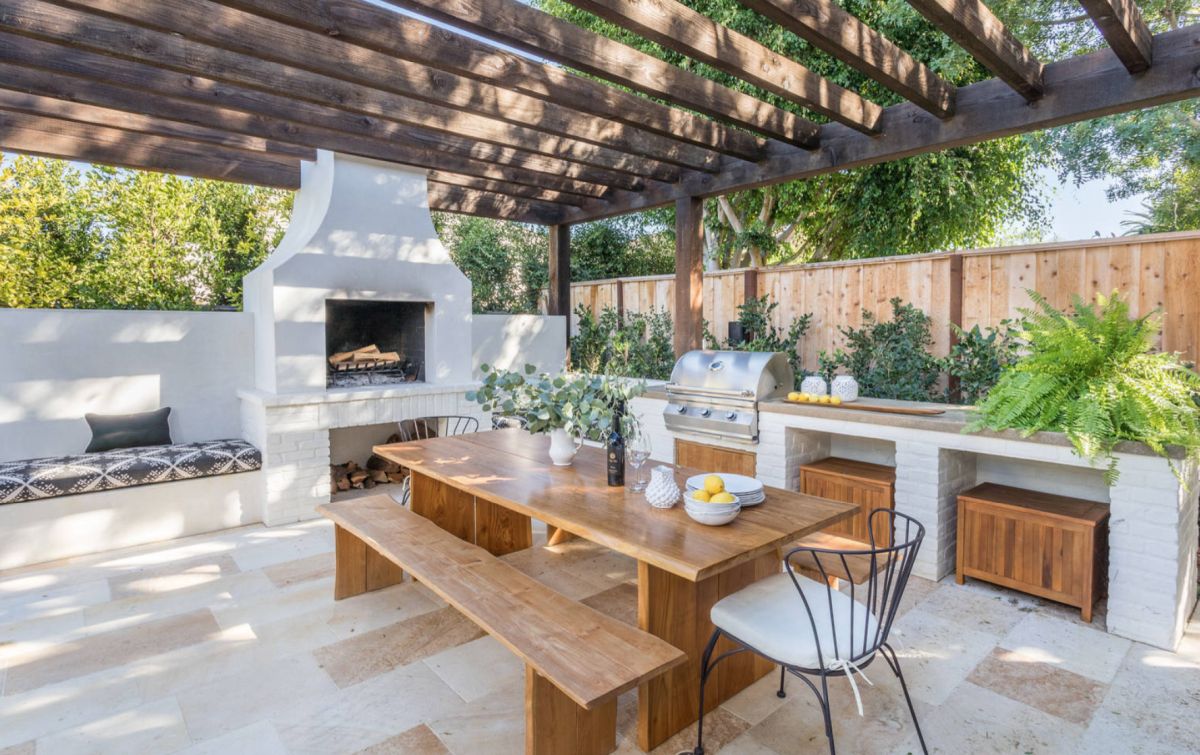The relaxed style of this travertine tile floor complements the historic style of this English kitchen. The uniform color of the stones keeps the look of the floor understated.

Travertine flooring is a natural stone alternative to ceramic tile that is a long-lasting and versatile option. Travertine flooring has attractive and vibrant earth tones that are a popular style trend. From creamy beige to deep rust and brown, travertine offers a lovely blend that works well with natural tones.
Travertine Flooring Basics

What is Travertine?

There are four main finishes available for travertine floor tiles: tumbled, brushed, honed, and polished.
Travertine is a porous stone, thus, it does absorb water. This quality makes travertine tile an ideal material for use on outdoor patios and decks. More water absorption means that water will not puddle and create slipping hazards.
Travertine Flooring Tile
It is vital that you maintain a seal for travertine on a regular basis in order to maintain its resistance to stains, scratches, and water. Use a penetrating sealant which will close the small pores in the stone. Reapply sealer to the tiles and grout every 3 years for the best protection.
- Unfilled Tile – Unfilled travertine tile leaves the characteristic holes in the travertine surface. This gives the tile a more rustic and textured look.
- Filled Tile – For filled travertine tile, manufactures fill the small holes with a binding substance to create a more sleek and sophisticated style tile.
Travertine Tile Finishes
Pay attention to the grout lines between the tiles. Take note of chipping or cracking grout and address it when you see problems.
- Tumbled Travertine Tile – Tumbled travertine has the most textured surface finish as well as rounded corners and edges Its uneven surface makes it more slip resistant than polished travertine tile.
- Brushed Travertine Tile – Manufacturers use wire brushes to create a matte, or flat, finish on brushed travertine tiles.
- Honed Travertine Tile – Honed travertine tile flooring has a smooth and polished texture that falls between gloss and matte.
- Polished Travertine Tile – Polished travertine floors have a glossy finish.
Water Resistance
Make sure to clean the grout lines while cleaning the tiles.
Try to avoid dropping heavy objects on travertine tile flooring. Save extra tiles from the initial tiling installation as tiles from other batches will not be an exact match. This way, you can replace any tiles that break.
Travertine tiles are an attractive feature in this contemporary rustic living room. The creamy beige colors complement the neutral shiplap walls and stone fireplace.
Travertine is a durable material. Used as one of the oldest building materials, it can last hundreds of years. It stands up well to heavy foot traffic but will show wear after many years of use. This is considered a plus by some homeowners who love its natural weathered style.
Durability

Make sure to clean up spills like red wine from unfilled travertine tile as it is prone to staining.
Travertine is a porous natural stone with the presence of distinctive small holes. These are a characteristic look, but not one that everyone desires. Travertine floor tile comes in two main types: unfilled and filled.
Travertine Flooring Maintenance
According to Forbes Home, popular color trends for 2022 and beyond are those inspired by nature. Beyond the lovely look of travertine flooring, it is a durable stone suitable for indoor and outdoor spaces, that complements a wide variety of styles.
Porous stones are not good in indoor areas that have exposure to water or debris, both common in the kitchen. In a kitchen, the best surface for travertine floors is tile that is filled and honed.
Travertine is a good choice for as a flooring material under certain conditions. Travertine is durable and beautiful, but it does require maintenance. You should use travertine in areas where it will not be exposed to heavy objects that can scratch or dent the surface. Rustic travertine will age well as long as you keep it sealed and clean.
How to Clean Travertine Floors
Travertine does scratch more than harder natural stones like granite. Scratches will be less visible on rustic finishes like tumbled or honed travertine flooring than polished tiles.
Travertine flooring tile enhances any room, but its unique qualities mean it works for some areas better than others. Homeowners use travertine tile indoors and outdoors. Travertine is popular in living rooms, bathrooms, and kitchens. Outdoor tile used on patios and decks is distinct from indoor tile For general purposes, tile for indoor use is 1/2 inch thick. Tiles for outdoor use range from 1 1/4 inch to 2 inches thick.
Location for Use
Standard indoor travertine tiles cost – per square foot. Premium travertine tile costs up to – per square foot. On average, travertine tile installation costs – per square foot.
Filled travertine flooring is less water absorbent and less prone to stains. Maintaining a sealer on travertine will keep travertine flooring more protected.
Installation
Travertine flooring is resistant under extreme temperatures which makes it an ideal surface for outdoor use.
Travertine Flooring Costs
Travertine is versatile and works with contemporary glam styles as well as rustic styles. Wilkinson Preservation used polished travertine tiles on the floor and walls to keep the bathroom sophisticated but simple.
Sweep or vacuum travertine floors at least every other day to avoid the build-up of dust and debris. If you have polished travertine tiles, avoid using a hard bristled vacuum head or broom as it may damage the finish. Mop to keep floors clean on a regular basis. Use a non-acidic cleaner that is formulated for natural stones and keep the mop wrung out rather than drenched in water.
Travertine Flooring: Pros and Cons
Installing travertine tile is not a popular DIY project. It is a hard stone, so it requires specialized equipment including a tile wet saw with a diamond blade. It is most common to get a flooring expert to do this job.
Pros
- Durability – Long wearing flooring that will last for years with proper maintenance.
- Value Added – Natural stone flooring will increase your real estate value.
- Cost – Travertine tiles are a more cost effective natural stone flooring than others.
- Appearance – Beautiful natural look and feel of stone with multiple color and size tile variations.
Cons
- Installation – Installation of travertine tiles is not easy for beginners, so this is not an ideal DIY project.
- Cost – Travertine tile has a higher price than other floors like laminates or vinyls.
- Feel – A travertine tile floor is cold underfoot, and polished travertine tile flooring is slippery when wet.
- Maintenance – Travertine must be sealed so that the small holes do not trap dust, debris, or grow mold.
Travertine Flooring Design Ideas
Travertine flooring is lovely, but it is not always right for every space. It is a very durable stone, but it must be treated with consideration to preserve its beauty. Yet, travertine will age with grace if you have the time and patience to invest in its care.
Rustic Travertine Tile

Travertine flooring is a unique and beautiful flooring. There are intrinsic issues with this type of flooring material that means that it works best in specific areas.
Travertine Bathroom Floor

For exterior travertine pavers, pay between – per square foot for materials with an additional – per cubic foot depending on the type of sub-base you need. Installation for outdoor travertine pavers ranges depending on who does the work. From masons to landscape architects, the costs range from per hour to 5 per hour.
Travertine Living Room Floor

Travertine pavers work well for patios as it is quick to absorb water. Also, the earth-toned stones create a look in keeping with the Mediterranean style design.
Outdoor Travertine Flooring Tiles
Until the 1980s, most supplies of travertine came from areas throughout Italy. Modern suppliers of travertine are Turkey, Mexico, China, Peru, and Spain.
The colors of travertine change based on minerals that exist around it when it is formed. There is light travertine ranging from creamy ivory to beige. There are yellow and green toned travertines. Also, there are darker travertines ranging from brown to red.
Travertine Kitchen Floor

The rounded corners and edges of this travertine tile create a rustic but classic look in this hallway. Also, the varied sizes and colors of the tile gives the room subtle depth and texture.
Frequently Asked Questions (FAQ)FAQ
What are the various travertine tile colors?
Travertine is a sedimentary rock and variety of limestone. It is created from a process of rapid precipitation of calcium carbonate near the mouth of hot springs or limestone caves. This creamy stone is used as an exterior building material, flooring, and countertops, and to define garden and patio spaces.
Is travertine out of style?
The post Travertine Flooring 101: The Basics of Care and Style appeared first on Homedit.
What is the best style and finish for travertine tiles in the kitchen?
Travertine flooring has qualities similar to other natural stone flooring materials like granite and marble. Yet, its unique qualities make it important to consider on its own.
Does travertine work well for floors?
Travertine is a classic material. It was used for building ancient buildings like the Colosseum and modern buildings like the Getty Center. It has been used as a flooring material for hundreds of years and will continue. Travertine has a versatile look that complements many design styles. While its popularity will rise and fall, there will always be people who utilize this gorgeous stone.
Conclusion
The location of use should determine the travertine tile finish. Polished stone works better in a kitchen because it is less water absorbent, Yet, it may not work in some bathrooms as it creates a slippery surface. Porous stones work well outdoors. They absorb water to prevent pooling but dry out in the sun and wind so do not breed mold.
Travertine tile is a popular style option for various design styles from farmhouse to modern. We have gathered some styles to inspire you with ways to incorporate travertine tile flooring in your home.